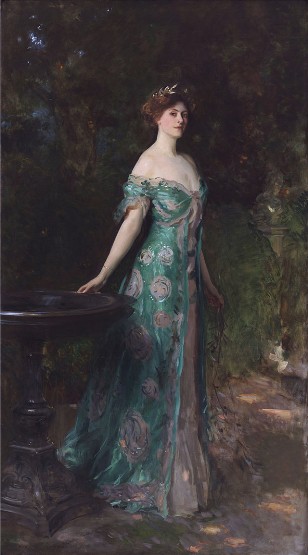
Portrait of The Duchess of Sutherland, 1904, by John Singer Sargent. (Thyssen-Bornemisza Museum, Madrid)
Millicent Sutherland-Leveson-Gower, The Duchess of Sutherland
20 October 1867 – 20 August 1955
Millicent Sutherland-Leveson-Gower, The Duchess of Sutherland (née Lady Millicent Fanny St. Clair-Erskine, was a British society hostess, social reformer, author, editor, journalist, and playwright, often using the pen name Erskine Gower. Her first husband was Cromartie Sutherland-Leveson-Gower, 4th Duke of Sutherland. By her two later marriages, she was known as Lady Millicent Fitzgerald and Lady Millicent Hawes, the latter of which was the name she used at the time of her death. She was born at Dysart House in Fife, the eldest daughter of the Scottish Conservative politician Robert St Clair-Erskine, 4th Earl of Rosslyn. Her sisters were Sybil Fane, Countess of Westmorland and Lady Angela Forbes.
Lady Millicent St. Clair-Erskine was married three times. She married Lord Cromartie Sutherland-Leveson-Gower, Marquess of Stafford, eldest son and heir of the 3rd Duke of Sutherland, on 20 October 1884, her 17th birthday. He inherited the Duchy of Sutherland on his father's death in 1892 and died in 1913. They had four children.
The family had homes in Scotland, Staffordshire and London. She became a great society hostess at their London home, Stafford House, associated with both the Marlborough House set and the Souls. She also developed a reputation as an advocate for social reform, although to a lesser extent than her half-sister Daisy Warwick. She was known as ‘Meddlesome Millie’ for her campaigning for better working conditions in the Potteries, near the family seat. Her caricature appears in Arnold Bennett’s Clayhanger Family novels as a countess with an ‘interfering meddlesomeness which so frequently exasperates the Five Towns’. However her campaign to remove lead paint glazes from Staffordshire pottery was successful.
After the outbreak of the First World War in August 1914, she organised an ambulance unit that saw active service in the siege of Namur, Belgium. Trapped behind enemy lines in Belgium, she escaped to England, where she wrote Six Weeks at the War. She returned to the continent in October to direct field hospitals in northern France. She moved with her unit to Roubaix in June 1918. For her war service, she was awarded the French Croix de guerre, the Belgian Royal Red Cross, and the British Red Cross medal.
She married Major (later Brig. Gen.) Percy Desmond Fitzgerald, 11th Hussars in October 1914, at which time she became known as Lady Millicent Fitzgerald. She was divorced from her second husband in 1919, on the grounds of his infidelity.
She married for a third time, to Lt. Col. George Hawes in October 1919. The marriage was unhappy due to her husband's homosexuality and they also divorced in 1925. A semi-autobiographical novel, That Fool of a Woman, was published in 1924.
She lived mostly in France through the 1920s and 1930s, and also travelled. She was living near Angers in 1940, and was captured after the German occupation of France. She escaped via Spain and Portugal to the United States, and returned to Paris in 1945.
She died in Orriule, near Sauveterre-de-Béarn, in south-west France on 20August 1955.
Her 1904 portrait by John Singer Sargent is now in Madrid. It was part of the estate of press agent Benjamin Sonnenberg, and was sold at auction by Sotheby's in 1979 for $210,000, setting a record for the artist's work.
She wrote novels, including One Hour and the Next (1899) and a collection of short stories, The Winds of the World (1902), and a play in blank verse. The Conqueror (1905) was performed at the Scala Theatre in London.
To make your own nomination download the nomination form here